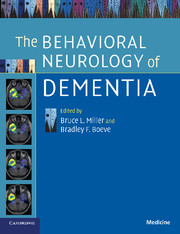Book contents
- Frontmatter
- Contents
- List of contributors
- Section 1 Introduction
- 1 Basic clinical approaches to diagnosis
- 2 Dementia with Lewy bodies
- 3 Neurogenetics of dementia
- 4 Frontotemporal dementia
- 5 Alzheimer's disease
- 6 Mental status examination
- 7 Neuropsychiatric features of dementia
- 8 Neuroimaging in dementia
- 9 Epidemiology and risk factors
- 10 Animal models of dementia
- 11 Neuropathology of dementia
- Section 2 Cognitive impairment, not demented
- Section 3 Slowly progressive dementias
- Section 4 Rapidly progressive dementias
- Index
- References
10 - Animal models of dementia
Published online by Cambridge University Press: 31 July 2009
- Frontmatter
- Contents
- List of contributors
- Section 1 Introduction
- 1 Basic clinical approaches to diagnosis
- 2 Dementia with Lewy bodies
- 3 Neurogenetics of dementia
- 4 Frontotemporal dementia
- 5 Alzheimer's disease
- 6 Mental status examination
- 7 Neuropsychiatric features of dementia
- 8 Neuroimaging in dementia
- 9 Epidemiology and risk factors
- 10 Animal models of dementia
- 11 Neuropathology of dementia
- Section 2 Cognitive impairment, not demented
- Section 3 Slowly progressive dementias
- Section 4 Rapidly progressive dementias
- Index
- References
Summary
Recent decades have witnessed major advances in diagnosing neurodegenerative diseases such as Alzheimer's disease (AD) and frontotemporal dementia (FTD), together with a wealth of new information about their clinical course and natural history. However, patients and physicians alike have been frustrated by the lack of available treatments. Solving this problem will require both a better understanding of the molecular mechanisms underlying these diseases and systems for screening the efficacy and safety of new therapeutics. There are several strategies for addressing these issues: studies of human patients themselves and human autopsy tissues, studies of animal models of disease, and more reductionist (cell culture or in vitro) models of disease. In this chapter, we will focus on animal models of neurodegenerative diseases, summarizing their relative advantages and disadvantages, highlighting some of the most important and widely studied models available, and reviewing a few important lessons that have emerged from animal model studies in recent years.
There is no question that studies of affected patients are the “gold standard” for understanding a human disease. As such, animal model studies depend fully on such human research. For example, human genetic studies has identified the mutations that have been used to generate most animal models of disease. Obviously, though, there are advantages to using animal models, and it is useful to consider them explicitly, as they help to clarify both the power and the limitations of animal models.
Ability to study early stages of the disease. Therapies are most likely to be effective when delivered early in the disease, before irreversible cell death or other changes occur, making it critical to understand the pathophysiology underlying initial stages.
[…]
- Type
- Chapter
- Information
- The Behavioral Neurology of Dementia , pp. 131 - 141Publisher: Cambridge University PressPrint publication year: 2009

